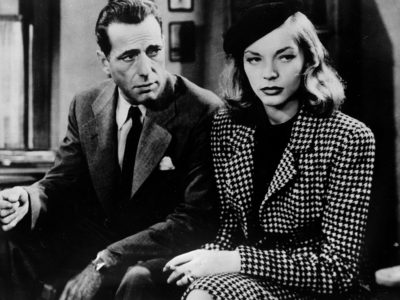The Big Sleep
Tropic Sprockets by Ian Brockway
[mr_rating_result]Howard Hawks’ noir classic “The Big Sleep” (1946) is known in cinema history and almost infamously so, for its overly complicated plot. Endless double crosses and miscommunication with some repetitive dialogue is in abundance. Nevertheless, the film is a knotty delight for its gorgeous cinematography and its mercurial women.
Marlowe (Humphrey Bogart) is summoned to help Sternwood (Charles Waldren) combat a blackmail threat presumably to his daughter Carmen (Martha Vickers) for her gambling debts. The blackmail plot involves Geiger (Theodore von Eltz) and numerous sociopaths. The character actor Bob Steele as the scary Canino is chief among them.
 Marlowe tails Geiger, flirts with several women then unwittingly finds Geiger dead on the carpet. What follows is a series of situational troubles and circumstances that might well confuse the famed logician Saul Kripke. Sternwood’s older daughter Vivian (Lauren Bacall) approaches Marlowe with incriminating photographs. This prompts him to go to the apartment of Joe Brody (Louis Jean Heydt) which leads to a Sternwood employee dead in a car accident.
Marlowe tails Geiger, flirts with several women then unwittingly finds Geiger dead on the carpet. What follows is a series of situational troubles and circumstances that might well confuse the famed logician Saul Kripke. Sternwood’s older daughter Vivian (Lauren Bacall) approaches Marlowe with incriminating photographs. This prompts him to go to the apartment of Joe Brody (Louis Jean Heydt) which leads to a Sternwood employee dead in a car accident.
In a dark alley, a badly beaten up Marlowe gets picked up by smarmy tough guy Harry Jones (Elisha Cook Jr.), only to be poisoned and left for dead. Marlowe is puzzled as to where this leads and at one point (according to online research) Hawks the cast and even the book’s author Raymond Chandler were clueless, specifically regarding to the aforementioned lake death.
For nearly two thirds of the film, mystery abounds. Just who is responsible for the family scandal. No one is sure and Marlowe is tight lipped and battered.
Actor Bacall is catlike, laconic and seductive, and Bogart is satisfyingly world-weary, his wrinkles filled with inky shadows as thick and viscous as black coffee.
Martha Vickers is terrific as the weird and chimerical younger sister reckless and amoral with a 1940s wardrobe to match.
The circumstantial predicaments may well lead to some head scratching if you don’t have your fedora at hand but Humphrey Bogart and Bacall alone are worth it. Disaster waits on every corner, most abruptly from a pointed leather shoe.
In what is almost the last scene, Bogart is huddled, his mouth next to a polished gunmetal wheel hub of a car which resembles a woman’s breast. As much as escape and liberty, the metal of the wheel hub in the noir realm represents sex and danger.
Confusion, death and a quizzical gin soaked face remain the only constants.
Write Ian at ianfree11@yahoo.com


Ratings & Comments
[mr_rating_form]